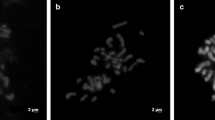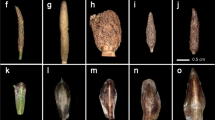Abstract
Chromosome numbers forEleocharis palustris subsp.palustris (based on 70 samples from Austria, Bulgaria, Croatia, the Czech Republic, Germany, Greece, Hungary, Lithuania, Romania, Russia, Slovakia, Slovenia, and Sweden) andEleocharis palustris subsp.vulgaris (based on 74 samples from Austria, the Czech Republic, Denmark, Germany, Ireland, Latvia, Luxembourg, the Netherlands, Portugal, and Sweden) are given. Also the chromosome number estimates based on relative DNA contents of plants from 8 localitiesE. palustris subsp.palustris from Croatia, the Czech Republic, Germany, Italy, Israel, and Slovenia, and from 18 localities ofE. palustris subsp.vulgaris from the Czech Republic, Germany and Sweden are included. InE. palustris subsp.palustris, 2n=16 prevailed, the mixoploid 2n=15, 16 was rare and a lone hypoploid 2n=15 was detected. InE. palustris subsp.vulgaris 2n=38 was most frequently detected, the hyperploid 2n=39 and mixoploid 2n=38, 39 were common, and the hypoploid 2n=36 and mixoploids in which 2n ranges from 36 to 42 were rarer. Distribution maps based on plants investigated either by chromosome counting or by flow cytometry, augmented by similar data from published sources are given for both subspecies in Europe.
Similar content being viewed by others
References
Avdulov N.P. (1931): Kario-sistematicheskoe issledovanie semeistva Zlakov (Karyosystematic study of the grass family).Trudy Prikl. Bot., Ser. 5, Zernov. Kul’t., Suppl. 43: 1–438.
Battaglia E. (1954): Assenza di centromero localizzato inHeleocharis uniglumis (Link)Schult. (Absence of localized centromere inHeleocharis uniglumis (Link)Schult.).Caryologia 6: 319–332.
Bir S.S., Cheema P., Kumari S. &Sidhu M. (1993): Occurrence of B-chromosomes and karyotypic analysis in sedge genusEleocharis R.Br.Curr. Sci. 64: 322–324.
Briggs B.G. (1970): Chromosome numbers in some Australian species ofEleocharis (Cyperaceae).Contr. New South Wales Natl. Herb. 4: 130–136.
Bureš P. (1998): A high polyploidEleocharis uniglumis s.l. (Cyperaceae) from Central and Southeastern Europe.Folia Geobot. 33: 429–439.
Bureš P., Horová L. &Stoneberg Holt S.D. (2003): Absolutní a relativní obsah DNA evropských zástupcůEleocharis subser.Eleocharis (Angiospermae, Cyperaceae) (Absolute and relative DNA content of European taxa ofEleocharis subser.Eleocharis (Angiospermae, Cyperaceae)). In:Kozubík A. (ed.),Analytická cytometrie II, Brno 11.–14. května 2003, Česká společnost pro analytickou cytologii, Brno, pp. 79–80.
Davies E.W. (1953): Some new chromosome numbers in theCyperaceae.Watsonia 3: 242–243.
Davies E.W. (1956): Cytology, evolution and origin of the aneuploid series in the genusCarex.Hereditas 42: 349–366.
Darlington C.D. &Wylie A.P. (1955):Chromosome atlas of flowering plants. George Allen & Unwin, London.
Doležel J. &Göhde W. (1995): Sex determination in dioecious plantsMelandrium album andM. rubrum using high-resolution flow cytometry.Cytometry 19: 103–106.
Doxey D. (1938):The cytology of Eleocharis palustrisand related species in Britain. PhD. Thesis, University of Manchester, Manchester. [cit. sec.Walters 1949]
Egorova T.B. (1981): GenerisEleocharisR. Br. (Cyperaceae) florae URSS systema et conspectus (Classification and synopsis of the genusEleocharisR. Br. (Cyperaceae) in the flora of the URSS).Novosti Sist. Vyssh. Rast. 18: 95–124.
González-Elizondo M.S. &Tena-Flores A.T. (2000):Eleocharis (Cyperaceae) in the New World. In:Wilson K.L. &Morrison D.A. (eds.),Monocots: Systematics and evolution, CSIRO Publishing, Sydney, pp. 637–643.
Gregor T. (2003):Eleocharis mamillata — distribution and infraspecific diferentiation.Folia Geobot. 38: 49–64.
Håkansson A. (1928): Die Chromosomen einiger Scirpoideen.Hereditas 10: 277–292.
Håkansson A. (1929): Über verschiedene Chromosomenzahlen inScirpus palustris L.Hereditas 13: 53–26.
Håkansson A. (1958): Holocentric chromosomes inEleocharis.Hereditas 44: 531–540.
Harms L.J. (1968): Cytotaxonomic studies inEleocharis subser.Palustres: Central United States Taxa.Amer. J. Bot. 55: 966–974.
Harms L.J. (1972): Cytotaxonomy of theEleocharis tenuis complex.Amer. J. Bot. 59: 483–487.
Hicks G.C. (1929): Cytological studies inCyperus, Eleocharis andEriophorum.Bot. Gaz. (London) 88: 132–149.
Hoshino T. &Onimatsu A. (1994): Cytogeographical studies ofCarex duvariana (Cyperaceae) with special references to meiotic configurations of intraspecific aneuploids.J. Jap. Bot. 69: 37–41.
Hoshino T. &Waterway M.J. (1994): Cytogeography and meiotic chromosome configuration of six aneuploids ofCarex conicaBoott (Cyperaceae) in Japan.J. Pl. Res. 107: 131–138.
Hoshino T., Rajbhandari K.R. &Ohba H. (2000): Cytological studies of eleven species ofCyperaceae from central Nepal.Cytologia 65: 219–224.
Jörgensen C.A., Sörensen T. &Westergaard M. (1958): The flowering plants of Groenland.Biol. Skr. 9/4: 1–172.
Kit Tan (1985): 7.EleocharisR. Br.. In:DavisP.H., MillR.R. &KitTan (eds.),Flora of Turkey and the East Aegean Islands 9, Univ. Press, Edinburgh, pp. 48–53.
Kozhevnikov A.E., Sokolovskaya A.P. &Probatova N.S. (1986): Ekologiya, rasprostranenie i khromosomnye chisla nekotorykh rastenii semeistvaCyperaceae sovetskogo Dalnego Vostoka (Ecology, distribution and chromosome counts in someCyperaceae from Soviet Far East).Izv. Sibirsk. Otd. Akad. Nauk SSSR 2: 57–62.
Kubát K. et al. (eds.) (2002):Klič ke květeně České republiky (Key to the flora of the Czech Republic). Academia, Praha.
Kuzmanov B.A. &Kozhuharov S.I. (1969): Chromosome numbers of flowering plants in Bulgaria. 2.Izv. Bot. Inst. (Sofia) 19: 109–115.
Levitskii G.A. (1940): Kariotipy nekotorykh par rodstvennykh form rastenii (Karyotypes of some pairs of related plant taxa).Bot. Zhurn. 25: 292–296.
Lewis K.R. &John B. (1961): Hybridization in a wild population ofEleocharis palustris.Chromosoma 12: 433–448.
Lindberg H. (1902): Die Nordeuropäischen Formen vonScirpus (Heleocharis) paluster L.Acta Soc. Fauna Fl. Fenn. 23/7: 1–16.
Löve Á. &Löve D. (1956): Cytotaxonomical conspectus of the Icelandic flora.Acta Horti Gothob. 20: 65–291.
Löve Á. &Löve D. (1981): [Reports]. In:Löve Á. (ed.), IOPB chromosome number report, LXXIII,Taxon 30: 829–861.
Löve Á. &Ritchie J.C. (1966): Chromosome numbers from central northern Canada.Canad. J. Bot. 44: 429–439.
Luceño M. &Castroviejo S. (1991): Agmatoploidy inCarex laevigata (Cyperaceae). Fusion and fission of chromosomes as the mechanism of cytogenetic evolution in Iberian populations.Pl. Syst. Evol. 177: 149–159.
Luceño M. &Guerra M. (1996): Numerical variation in species exhibiting holocentric chromosomes: a nomenclatural proposal.Caryologia 49: 301–309.
Meusel H., Jäger E. &Weinert E. (1965):Vergleichende Chorologie der zentraleuropäischen Flora. G. Fischer Verlag, Jena.
Mehra P.N. &Sachdeva S.K. (1975): Cytology of some W. HimalayanCyperaceae.Cytologia 40: 497–515.
Murín A. (1974):Eleocharis palustris (L.)Roem. etSchult. In:Májovský J. et al., Index of chromosome numbers of Slovakian flora (Part 4),Acta Fac. Rerum Nat. Univ. Comenianae, Bot. 23: 8.
Murín A. &Feráková V. (1981): Caryological study of Slovakian flora III.Acta Fac. Rerum Nat. Univ. Comenianae, Bot. 28: 59–62.
Ohkawa T., Yokota M. &Hoshino T. (2000): Aneuploidal population differentiation inCarex sociataBoott (Cyperaceae) of the Ryukyu Islands, Japan.Bot. J. Linn. Soc. 132: 337–358.
Otto F. (1990): DAPI staining of fixed cells for high-resolution flow cytometry of nuclear DNA. In:Crissman H.A. &Darzynkiewicz Z. (eds.),Methods in cell biology 33, Academic Press, New York, pp. 105–110.
Otzen D. (1962): Chromosome studies in the genusScirpus L., sectionSchoenoplectusBenth. etHook., in the Netherlands.Acta Bot. Neerl. 11: 37–46.
Penev I. (1964): Blatnica —HeleocharisR. Br. In:JordanovD. (ed.),Flora na Narodna Republika Blgariya 2(Flora of the National Republic of Bulgaria 2), Izdat. na Blgarskata Akademiya na Naukite, Sofia, pp. 38–40.
Piech K. (1924): O podziale pierwotnego jadra komórki pylkowej i tworzeniu sie komórek plemnikovych uScirpus paluster L. (Primary pollen nucleus division and the origin of sperm cells inScirpus paluster L.).Bull. Int. Acad. Polon. Cl. Sci. Math., Sér. B, Sci. Nat. 7/8B: 605–621.
Pikner R. &Bureš P. (2002): CytogeografieEleocharis subser.Eleocharis v jihovýchodní Evropě (Cytogeography ofEleocharis subser.Eleocharis in southeastern Europe).Zprávy Čes. Bot. Společn. 37: 21–26.
Pogan E. (1971):EleocharisR. Br. In:Skalińska M., Pogan E. et al., Further studies in chromosome numbers of Polish Angiosperms, Ninth contribution,Acta Biol. Cracov., Ser. Bot. 14: 206–207.
Pogan E. (1972): Studies inEleocharisR.Br. I. Chromosome numbers ofE. palustris (L.) R. et S. andE. uniglumis (Link)Schult.Acta Biol. Cracov., Ser. Bot. 15: 69–75.
Pogan E. (1974):EleocharisR. Br. In:Skalińska M., Małecka J., Izmaiłow R. et al., Further studies in chromosome numbers of Polish Angiosperms, Tenth contribution,Acta Biol. Cracov., Ser. Bot. 17: 156.
Pogan E. (1980):HeleocharisR. Br. In:Pogan E., Wcisło H., Jankun A. et al., Further studies in chromosome numbers of Polish Angiosperms, Part XIII,Acta Biol. Cracov., Ser. Bot. 22: 60–61.
Pólya L. (1948): Chromosome numbers of certain alkali plants.Arch. Biol. Hung. 18: 145–148.
Preston C.D. &Croft J.M. (1997):Aquatic plants in Britain and Ireland. B. H. & A. Harley Ltd., Colchester.
Rath S.P. &Patnaik S.N. (1974): Cytological studies inCyperaceae with special reference to its taxonomy I.Cytologia 39: 341–352.
Saunte L. H. (1958): Chromosome variation in theHeleocharis palustris — uniglumis complex.Nature 181: 1019–1020.
Saynal B. &Sharma A. (1972): Cytological studies in IndianCyperaceae II. TribeCypereae.Cytologia 37: 13–32.
Schuyler A. E. (1977): Chromosome observations on some eastern North AmericanEleocharis (Cyperaceae).Brittonia 29: 129–133.
Silvestre S. (1980): Numeros 150–154. In: Nérumos cromosómicos para la flora Española. 121–182,Lagascalia 9: 266–269.
Stoeva M. P. (1985): Chromosome numbers of Bulgarian angiosperms.Fitologiya 30: 78–79.
Strandhede S.-O. (1958):Eleocharis, subseriesPalustres, i Skandinavien och Finland. Preliminärt meddelande (Eleocharis, subseriesPalustres in Scandinavia and Finland. Preliminary report).Bot. Not. 111: 228–236.
Strandhede S.-O. (1960): A note on Scirpuspalustris L.Bot. Not. 113: 161–171.
Strandhede S.-O. (1961):Eleocharis palustris in Scandinavia and Finland. Taxonomical units within the area.Bot. Not. 114: 417–434.
Strandhede S.-O. (1965a): Chromosome studies inEleocharis, subser.Palustres. I. Meiosis in some forms with 15 chromosomes.Hereditas 53: 47–62.
Strandhede S.-O. (1965b): Chromosome studies inEleocharis, subser.Palustres. II. Pollen mitosis with special reference to some strains with 15 chromosomes, and formation of secondarily unreduced pollen grains.Hereditas 53: 374–388.
Strandhede S.-O. (1965c): Chromosome studies inEleocharis, subser.Palustres. III. Observations on Western European taxa.Opera Bot. 9/2: 1–86.
Strandhede S.-O. (1965d): Chromosome studies inEleocharis, subser.Palustres. IV. A possible case of an extra, reductional division giving rise to hemi-haploid pollen nuclei.Bot. Not. 118: 243–253.
Strandhede S.-O. (1966): Morphologic variation and taxonomy in EuropeanEleocharis, subser.Palustres. Opera Bot. 10/2: 1–187.
Strandhede S.-O. (1967):Eleocharis, subser.Eleocharis in North America: Taxonomical comments and chromosome numbers.Bot. Not. 120: 355–368.
Strandhede S.-O. &Dahlgren R. (1968): Drawings of Scandinavian plants 9–12.EleocharisR. Br.Bot. Not. 121:1–10, 145–152.
Tanaka N. (1942): Chromosome studies inCyperaceae. XVII. Chromosome numbers in the genusHeleocharis and allied genera.Med. & Biol. 2: 96–100.
Thiébaud M.-A. (1970): Contribution à l’étude caryologique du genreEleocharisR. Br. en Suisse.Candollea 25/2: 209–219.
Walters S.M. (1949):EleocharisR. Br. (Biological flora of the British Isles.).J. Ecol. 37: 192–206.
Walters S.M. (1950):Variation in Eleocharis palustresagg. PhD. Thesis, University of Cambridge, Cambridge. [cit. sec.Strandhede 1965c].
Walters S.M. (1959):Heleocharis austriacaHayek andGlyceria declinataBréb., two plants new to the flora of Poland.Fragm. Florist. Geobot. 5: 239–244.
Walters S.M. (1980):EleocharisR. Br. In:TutinT.G. et al. (eds.),Flora Europea 5, Cambridge University Press, Cambridge, London, New York, New Rochelle, Melbourne & Sydney, pp. 281–284.
Záborský J. (1978):Eleocharis palustris (L.)Roem. etSchult. In:Májovský J. et al., Index of chromosome numbers of Slovakian flora (Part 6),Acta Fac. Rerum Nat. Univ. Comenianae, Bot. 26: 1–42.
Żukowski W. (1965): RodzajEleocharisR. Br. v Polsce (GenusEleocharisR. Br. in Poland).Prace Komis. Biol. 30/2: 1–113.
Author information
Authors and Affiliations
Corresponding author
Rights and permissions
About this article
Cite this article
Bureš, P., Rotreklová, O., Holt, S.D.S. et al. Cytogeographical survey ofEleocharis subser.Eleocharis in Europe 1:Eleocharis palustris . Folia Geobot 39, 235–257 (2004). https://doi.org/10.1007/BF02804780
Received:
Revised:
Accepted:
Issue Date:
DOI: https://doi.org/10.1007/BF02804780




